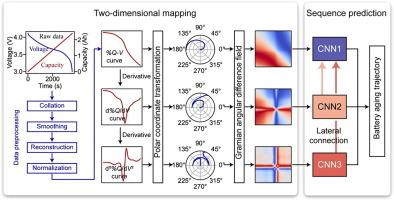优化电池部署:老化轨迹预测实现同质性能分组
IF 13.1
1区 化学
Q1 Energy
引用次数: 0
摘要
随着电动汽车和储能系统中电池部署的增加,确保各单元的性能均匀至关重要。我们提出了一种多衍生成像融合(MDIF)模型,利用先进的成像和机器学习技术,从最少的初始数据中预测电池老化轨迹,从而在部署前进行有效的性能分组。MDIF 模型利用导数策略和格拉米安角差场进行维度增强,仅在十个周期后就能从放电曲线数据中发现微妙的预测特征。该架构包括一个具有横向连接的并行卷积神经网络,以加强特征整合和提取。该模型在自主开发的数据集上进行了测试,其平均均方根误差为 0.047 Ah,平均绝对百分比误差为 1.60%,显示了较高的精度和可靠性。通过在两个公开数据集上进行迁移学习,该模型的稳健性得到了进一步验证,只需最小限度的再训练即可适应。这种方法大大减少了所需的测试周期,降低了与电池测试相关的时间和成本。通过利用有限的数据实现精确的电池行为预测,MDIF 模型优化了电池利用和部署策略,提高了系统效率和可持续性。本文章由计算机程序翻译,如有差异,请以英文原文为准。

Optimizing battery deployment: Aging trajectory prediction enabling homogenous performance grouping
As battery deployments in electric vehicles and energy storage systems grow, ensuring homogeneous performance across units is crucial. We propose a multi-derivative imaging fusion (MDIF) model, employing advanced imaging and machine learning to predict battery aging trajectories from minimal initial data, thus facilitating effective performance grouping before deployment. Utilizing a derivative strategy and Gramian Angular Difference Field for dimensional enhancement, the MDIF model uncovers subtle predictive features from discharge curve data after only ten cycles. The architecture includes a parallel convolutional neural network with lateral connections to enhance feature integration and extraction. Tested on a self-developed dataset, the model achieves an average root-mean-square error of 0.047 Ah and an average mean absolute percentage error of 1.60%, demonstrating high precision and reliability. Its robustness is further validated through transfer learning on two publicly available datasets, adapting with minimal retraining. This approach significantly reduces the testing cycles required, lowering both time and costs associated with battery testing. By enabling precise battery behavior predictions with limited data, the MDIF model optimizes battery utilization and deployment strategies, enhancing system efficiency and sustainability.
求助全文
通过发布文献求助,成功后即可免费获取论文全文。
去求助
来源期刊

Journal of Energy Chemistry
CHEMISTRY, APPLIED-CHEMISTRY, PHYSICAL
CiteScore
19.10
自引率
8.40%
发文量
3631
审稿时长
15 days
期刊介绍:
The Journal of Energy Chemistry, the official publication of Science Press and the Dalian Institute of Chemical Physics, Chinese Academy of Sciences, serves as a platform for reporting creative research and innovative applications in energy chemistry. It mainly reports on creative researches and innovative applications of chemical conversions of fossil energy, carbon dioxide, electrochemical energy and hydrogen energy, as well as the conversions of biomass and solar energy related with chemical issues to promote academic exchanges in the field of energy chemistry and to accelerate the exploration, research and development of energy science and technologies.
This journal focuses on original research papers covering various topics within energy chemistry worldwide, including:
Optimized utilization of fossil energy
Hydrogen energy
Conversion and storage of electrochemical energy
Capture, storage, and chemical conversion of carbon dioxide
Materials and nanotechnologies for energy conversion and storage
Chemistry in biomass conversion
Chemistry in the utilization of solar energy
 求助内容:
求助内容: 应助结果提醒方式:
应助结果提醒方式:


